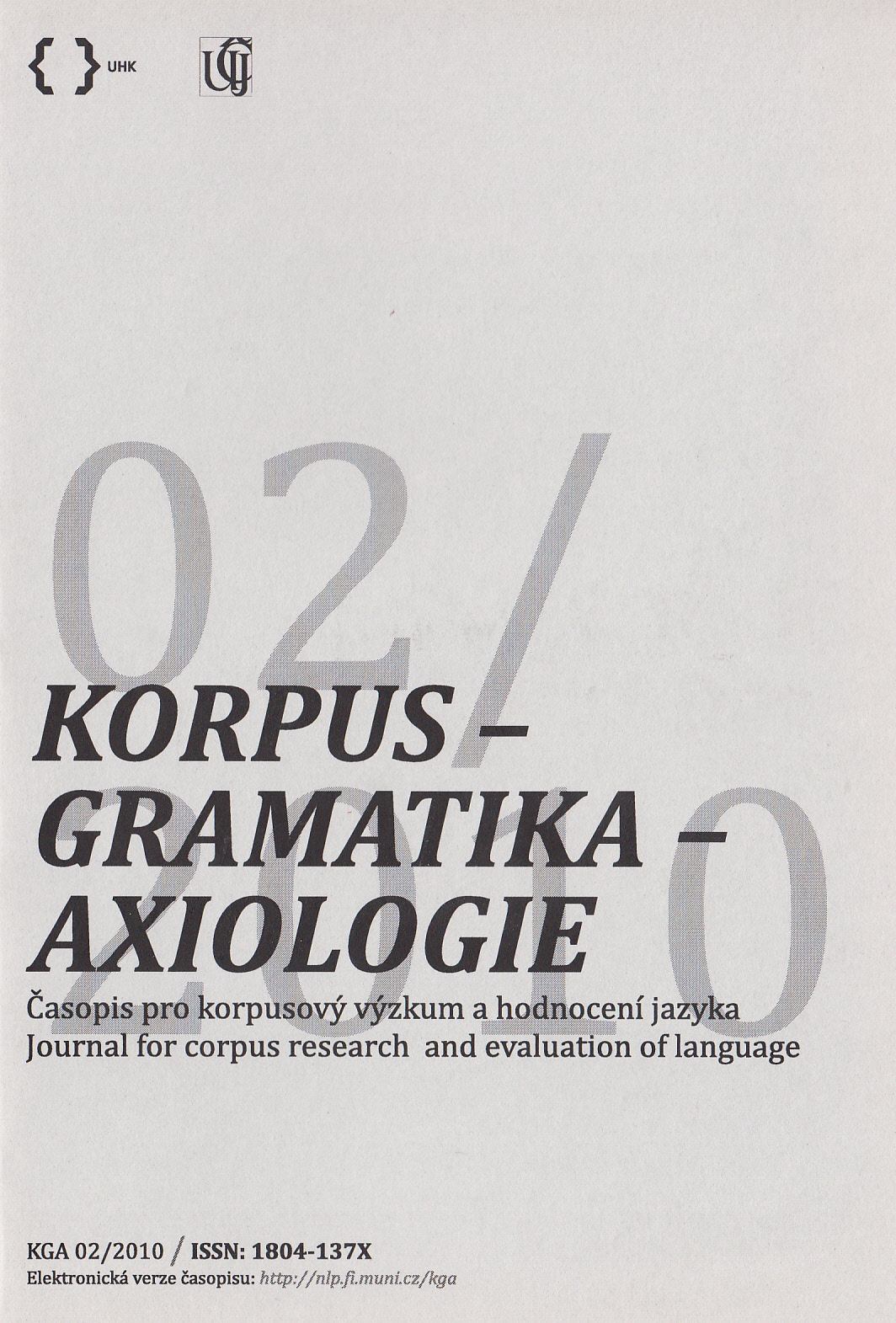
We kindly inform you that, as long as the subject affiliation of our 300.000+ articles is in progress, you might get unsufficient or no results on your third level or second level search. In this case, please broaden your search criteria.

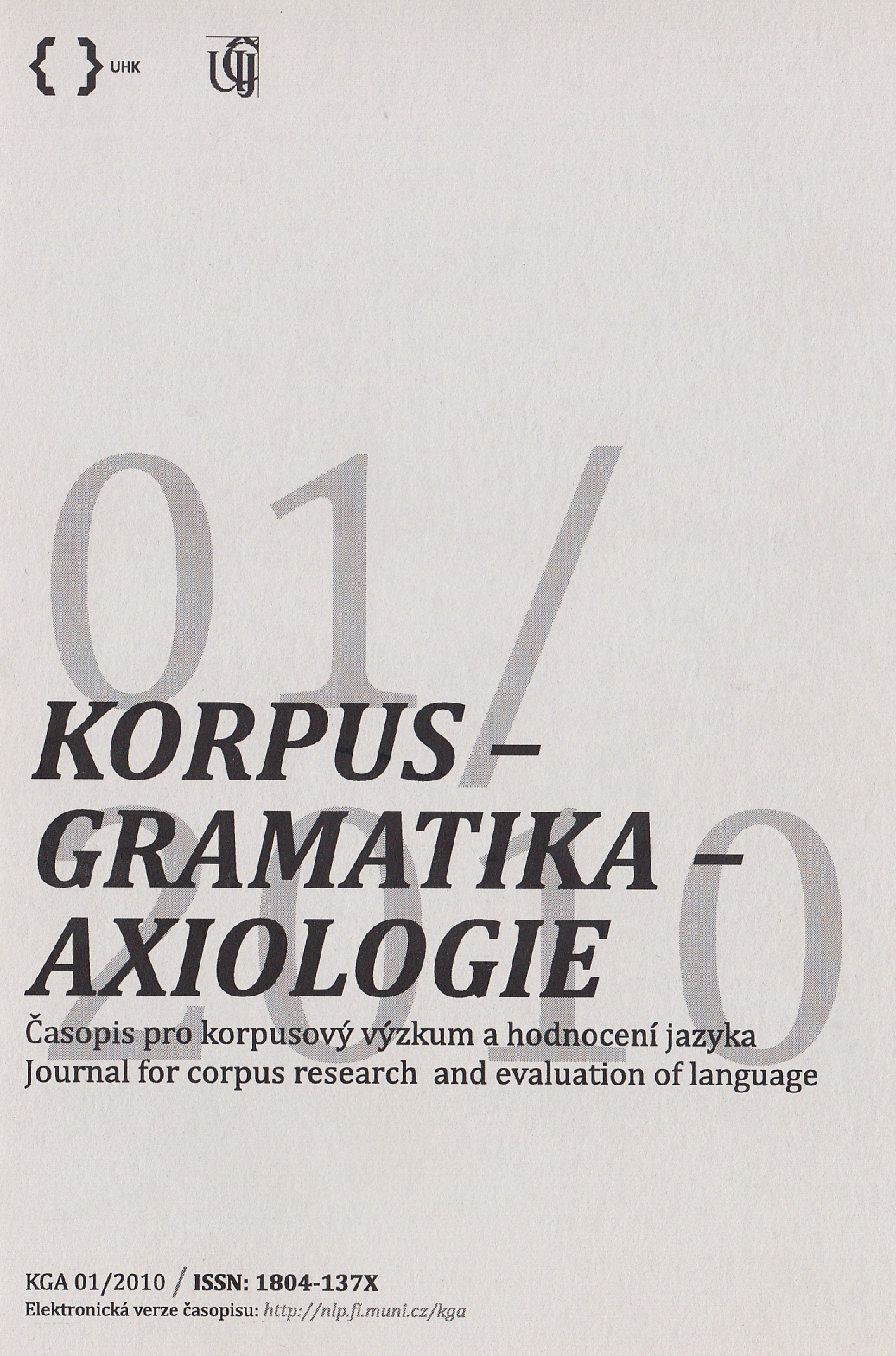

The article deals with a Czech lexeme zvíci, which is quite frequently used in a contemporary Czech language. This type of words was created in the 14th century; it is composite word consisting of a noun viecě and a preposition vz- form the origin. The article refers about formal and semantic changes and using of the lexeme zvíci (and simi-lar words) from the Middle-ages to today. Many quotations from synchronic and also diachronic corpus of Czech language are included.
More...
NOWADAYS, RADIO IS THE MOST ACCESSIBLE AND FASTEST MEANS OF GIVING INFORMATION, WHICH IS CONFIRMED BY THE LARGE NUMBER OF CHANNELS IN THE MASSMEDIA NETWORK. MANY RADIO JOURNALISTS HAVE USED A RADIOPHONIC STYLE WHOSE TRAITS ARE ORALITY AND INFORMALITY. THE JOURNALIST’S SPEECH MUST BE SIMPLE, SHORT AND CLEAR. THE LISTENERS TAKE FROM IT CERTAIN EXPRESSIONS, FORMS OF GREETING, AND NEOLOGISMS TOO. THE CONNEXION BETWEEN LISTENERS AND THE RADIO HOST IS ONE FULL OF SERIOSITY, THE HOST PLAYS HIS ROLE DEPENDING ON THE PUBLIC, AND THEY SEE THE MESSAGE THROUGH THE HOST S EYES. THE TWO RADIO SHOWS WE WILL TAKE INTO CONSIDERATION ARE CRONICA CÂRCOTAȘILOR WHICH PLAYS FROM 7 TO 10 AM, DURING RADIO CONTACT KISS FM, HOSTED BY SERBAN HUIDU AND MIHAI GAINUSA AND NAȚIUNEA 21,WHICH PLAYS FROM 10 TO 11 AM, RADIO 21 HOSTED BY ANDREI GHEORGHE. THESE SHOWS HAVE A LARGE NUMBER OF LISTENERS BECAUSE OF THEIR RADIO HOSTS SUCCESS WHO ARE KNOWN TO BE FAMOUS. THE ARTICLE WILL EXAMINE THE LINGVSTIC CHARACTERS OF THE JOURNALISTIC SPEECH AND THE METHOD OF TRANSMITING A MESSAGE. THESE SHOWS HAVE BEEN RECORDED DURING THE 27TH OF OCTOBER AND THE 13TH OF NOVEMBER 2003.
More...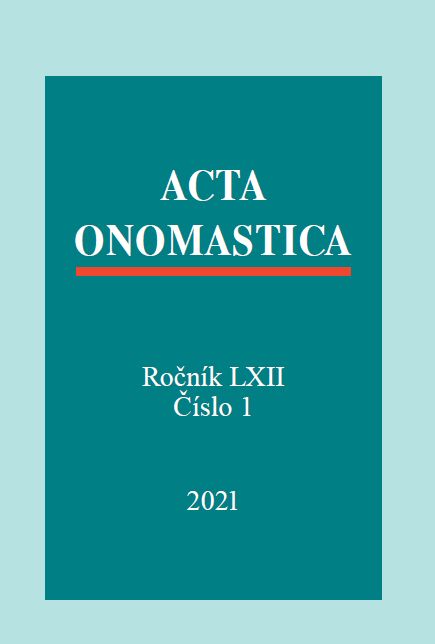
The paper discusses the use of proper names of male cattle (Bos taurus) in the poetry collection Living Treasure (Živo blago, 1997) by Radenko Stanić. The author used the real proper names for purebred cattle in the literary text, describing oxen, cows, and other domestic animals on farms in the verses. The goal of the paper is to extract the inventory of zoonyms which are used to name male cattle, to examine the prin¬ciples of the poet’s choice of zoonymic units, as well as their stylistic functions. The analysis has shown that the inventory of oxen zoonyms is comprised of: (1) traditional proper names, which are present in lexicographical sources, as well as in ono¬mastic studies done in the field; (2) modern proper names, which originate under the influence of the urban culture, film, literature, and comics. What is noticeable is the merging of modern zoonymy into rural zoonymy. The stylistic function of proper nouns for oxen is achieved on a meaningful plan ‒ they contribute to the comic outlook on the world and partake in the linguo-cultural range of the poems.
More...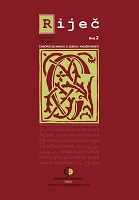
An expressive-emotional impression that sevdalinka makes on a listener can primarily be explained by linguistic tools it is made with. Sevdalinka creates semantic perspective in which words turn into poetic imagery in the process of multi-metamorphosis. Poetic images contain a basic scheme of a poet’s conception and it is that conception that should be discovered. That is possible only with good understanding of the secret of language of sevdalinka, which represents a pattern of fragrance, melodiousness, simple and pure form, grace of emotional expression, pattern of the essence of lyrics etc. In simple words, we have shown in our paper that sevdalinka represents an inexhaustible well of linguistic turns, stylistic patterns and layered metaphors.
More...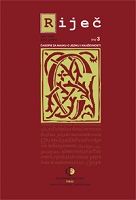
The author points out the complexity and numerousness of the stylistic literary tools, used by Mihailo Lalic while organizing the novel. Their numerousness and complexity create the aesthetic value of the language of the novel. The author of the paper believes that Lelejska gora is the most valuable novel written by Mihailo Lalic due to its evident and complex figurativeness.
More...
This paper presents a narratological analysis of Maupassant’s short story, „La Peur.“ The author attempts to present the ways a tale like „La Peur“ may be read with the help of the categories that Gérard Genette proposes for analyzing narrative discourse. The analysis of narrative discourse requires the study of certain relations that exist—between the discourse and the narrated events on the one hand, and between the discourse and the act of its production (be it fictitious or real) on the other. The objective of the paper is to demonstrate that the narratological apparatus deployed in this story by Maupassant belonging to the realist school fulfils a function to influence the listener/reader.
More...
Television implies a specific communication, a situational framework, it offers us an image of the enunciator, of the recipient and even an image of a relationship that is proposed in and through discourse. The recorded and analysed corpus is dialogical and conversational at the same time, because it involves several enunciators but also several speakers. The debate is controversial but also involves cooperation, at some points. Emphasis is placed on polemical strategies, on divergences between the points of view that involve rejecting and attacking the other's arguments.
More...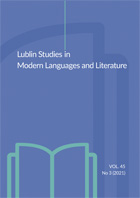
This paper aims to illustrate the big impact of conceptual metaphors on the perception and subsequent conceptualization of pain of women suffering from endometriosis. This article is based on a selection of posts published on a Facebook group that concerns the symptoms of endometriosis disease. The results of the analysis may contribute to a wider understanding of endometriosis.
More...
Metaphor is mental mechanism of cognition and central category of semantics. However, as an object of pragmatization it appears in literary texts in word games. In the article problems of translation of such experimental metaphor are discussed. In the background are cognitive aspects of language and literary translation, where changes in linguistic form in translation can shed light on mental mechanisms of interpretation and translation. Differences between the structures of languages move the translator to self-evident structural changes, the obligatory transpositions. From the linguistically grounded, translational point of view, the paper discusses the question of whether and, if so, how transposition can influence invariance relations in translation.
More...
The focus of the present paper is the treatment of metaphorical terms in the Latvian term formation and translation practice, and the approaches to seeking Latvian equivalents for English metaphorical terms. The work undertaken in the development of bilingual dictionaries has brought to the fore the potential conflict between metaphorical terms and the strict prescriptivist rules that exist in Latvian term formation, that no ambiguity is permissible and metaphoricity should be ousted. Yet cognitive linguistics has unveiled the capacity of abstract thought and abstract reasoning in the formation of metaphorical terminology and that metaphor is at the basis of meaning formation. There are several approaches to seeking Latvian equivalents for English metaphorical terms yet in translation and interpreting practice loan translation still prevails. Over the recent years there has been evidence of a more determined return to metaphorical terms in Latvian as a significant element in the organization of the conceptual system of the language. Time will show, which trend will prevail though at present it seems that metaphorical terms in Latvian have come to stay.
More...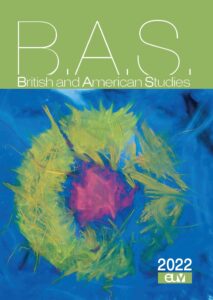
Stylistically, The Silence (2020) does not stray far from most of Don DeLillo’s 21st-century novels. As early criticism has noted, the key to decoding this slim volume’s significations lies not in its plot, setting, or character, but in theme and, significantly, in its language. By using corpus stylistics’ keyword approach, my paper argues in favour of “time” as a thematic binding element between The Silence and DeLillo’s other 21st -century novelistic endeavours. Moreover, the paper explores the ramifications of this theme in the post-technological setting posited by the novel.
More...
This article attempts to highlight relationships between poems from the collection Vade-mecum and Norwid’s epistolography. These ties manifest not only on the genetic level, but also in terms of themes as well as stylistic and lexical elements (including key words), primarily with regard to the use of communication structures. What draws attention in these poems is the use of dialogue and the incorporation of colloquial and epistolographic phrases.In his letters, on the other hand, the poet displays a predilection for saturating certain passages with formulas and expressions of distinctly poetic character.
More...
This paper focuses on an analysis of the emotive-evaluative discourse of the linguistic personality of the clergyman. Using a set of software tools for processing language corpora developed by Lexical Computing Ltd., a quantitative analysis was carried out of the text of “The Sermon for Holy Trinity Day. Pentecost” (8 June 2014). The subject of the study was the text of sermon No 4, which had evoked a huge response in society. Its author was Archpriest Dimitry Smirnov. The study was conducted not only from the perspective of corpus linguistics, but also from that of discourse theory, the components of which are religious discourse and emotive-evaluative discourse. The understanding of the concept of linguistic personality was also discussed. As a result of the study, the main concept of “Man” in the preacher’s discourse was selected and the most important communicative parameters, such as expressivity and informality, were identified. Among the pretextual presuppositions of the text of the sermon is the knowledge the preacher received at school, which placed a particular emphasis on mathematics and physics.
More...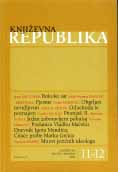
Tekst ispituje odnose alazona i eirona, standarda i narječja, prostora i vremena te intertekst i intratekst Šopovih dramskih djela objavljenih u knjizi Kroz vrevu stećaka.
More...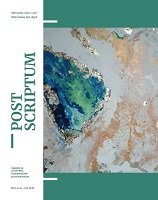
Phrases whose problems are in this paper are excerpted from the works of Martin Mikulić, a Herzegovinian Franciscan writer. Mikulić left behind a great literary wealth worth scientific observation - especially in the field of phraseology. Namely, the paper deals with the semantic aspect of phrases created through different tropes. The phrases created through metaphor, ie. metaphorical formulas where, for example, the loss of a head is equal to the loss of life. Other examples have been created according to the same principle, where body parts appear as components of phrases and other various components can be found. In addition to phrases created through metaphor, metonymy, synagogue, the material also confirms phrases created through periphrasis, hyperbole, euphemism, irony, antithesis and comparison. In addition, attention in this paper was focused on the definition, form and structure of phrases. Thus, the material confirms phrases with one full word, phrases with two or more independent words with or without auxiliary words, as well as phrases of a sentence. In the scientific literature, many authors share the opinion that the structure of phrases is usually solid, which is not shown by the examples from the corpus where a certain type of change in the structure of phrases was made. Apart from variant forms in which there is no change in meaning but in expression, so it is one or more alternative forms of phrases - other modifications are reflected in the fact that the order of components in the phrase is not solid and stable, that it is possible to replace one component the second as well as in changes of syntactic nature (prepositional-case connection), then the addition of certain components as well as the reduction of components, etc. The corpus confirms phrases whose phraseological components have lost their denotative meaning as well as examples where some of the phraseological components retain their denotative meaning.
More...
Employing Steen’s three-dimensional model of metaphor analysis (2008, 2011b), the paper examines the use of the linguistic metaphor storm clouds as a perspective-changing cognitive device in public discourse on COVID-19.
More...
The paper examines whether rhetorical questions (RQs) with insulting content or implications soften or intensify the insulting content that they express, as compared to corresponding direct statements with similar insulting content. The analysis is based on the results of two online surveys conducted among 276 Bosnian university students (182 and 94, respectively), who evaluated, in regard to their offensiveness, two sets of RQs and corresponding statements with insulting content or implications. Three types of insulting RQs were included in the surveys: insulting RQs without explicitly offensive terms, insulting RQs that incorporate derogatory words, and sarcastic RQs with insulting implications. The expected results were that: a) in line with Frank’s (1990) account of strengthening effects of RQs as their primary function, insulting RQs, with or without derogatory words, will function as amplifiers, and sound more offensive than corresponding declaratives; and b) sarcastic RQs, following Dews and Winner’s (1995) account of softening effects of sarcastic utterances, will function as mitigators, as compared to non-sarcastic declaratives with insulting content. The obtained results indicate that the first hypothesis cannot be verified (in spite of some indications that slight amplifying effects do exist), and the second hypothesis is completely rejected, with some likelihood that the opposite could be true.
More...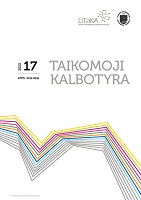
In order to solve issues in sign language linguistics, address matters pertaining to maintaining high quality of sign language (SL) translation, contribute to dispelling misconceptions about SL and deaf people, and raise awareness and understand of the deaf community heritage, this article, for the first time in a Lithuanian scientific journal, discusses authentic poetry in Lithuanian Sign Language (LSL) and inherent metaphors that are created by using the phonological parameter – location. The study covered in this article is twofold, involving both the micro-level analysis of metaphors in terms of location as a sub-lexical feature and the macro-level analysis of the poetic context. Cognitive theories underlie research of metaphors in sign language poetry in a range of sign languages. The study follows this practice. In view of the abovementioned reasons, this piece of research is new and relevant to Lithuania. The article covers qualitative analysis of 10 pieces of LSL poetry. The analysis employs ELAN software widely used in sign language research. The target is to examine how specific types of location are used for the creation of metaphors in LSL poetry and what metaphors are created. The results of the study show that LSL poetry employs a range of locations resulting in a host of metaphors created by using classifier signs and by modifying the location of the established signs. The study also reveals that LSL poetry mostly tends to create reference metaphors indicating status and power. As the study shows, LSL poets metaphorically encode status by encoding another meaning in the same sign, which results in creating double metaphors. The metaphor of identity has been determined to consist of chest signing. Notably, the poetic context has revealed that the latter metaphor can also be identified as a metaphor of life. The study goes on to note that deaf poets create metaphors related to the importance of various phenomena, significance of the lyrical subject. Notably, the study has allowed detecting locations never mentioned in previous SL research as used for the creation of metaphors. For instance, previous SL research fails to cover temporal metaphors expressed by signing in central and peripheral areas and attitudinal metaphors represented by signing near the eye. The study has also detected a sign that can be identified as a metaphor of death and that is absent in previous SL research.
More...